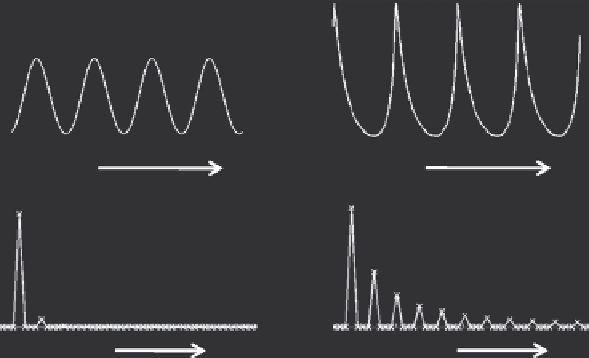Biomedical Engineering Reference
In-Depth Information
This assumes that the particle velocity is very small («
c
) and that
the relationship between pressure and density is linear. The lin-
ear approximation assumes that there is no heat transfer during
the wave propagation. A more accurate description is given by
the Taylor expansion:
5.4 Interactions of Ultrasound
with tissue
As described, the resulting effects of a propagating pressure
wave on tissue can be both thermal and mechanical in origin.
This section deals for the most part with the heating of tissue
through absorption of acoustic energy, however, mechanical
effects can also have a significant bearing on the overall thera-
peutic outcome and are therefore also addressed.
Section 5.3 describes the propagation of ultrasound under
“free field” conditions, such as occur in a large water bath, and
we have seen that attenuation occurs due to a combination of
absorption and scatter. These effects become more prominent
when an ultrasound wave travels through a medium such as
human tissue. As described previously, the speed of propagation
of ultrasound is a pressure-dependent parameter, resulting in
changes in the nature of a propagating wave. More specifically,
the progressive distortion of the wave form with distance trav-
eled at high pressure amplitudes leads to the generation of har-
monic frequency components (see Equation 5.18 and Figure 5.4).
The levels of attenuation, scattering, and absorption that occur
during this process are dependent on the specific properties of
the medium traversed as well as the acoustic field parameters. For
a plane wave propagating in a homogeneous medium, the total
transmitted power experiences an exponential decay, dependent
on the attenuation coefficient, which includes absorption and
scatter. Measurement of these components in isolation is diffi-
cult, however, values for many tissue types have been reported
in the literature (Duck 1990, Goss et al. 1979).
2
3
+
−=
−
ρρ
ρ
B
ρρ
ρ
−
C
ρρ
ρ
−
PP A
0
0
+
0
+
(5.18)
0
2
3
0
0
0
∂
∂
2
p
∂
∂
3
p
B
=
ρ
2
,
C
=
ρ
3
0
0
ρ
2
ρ
3
Commonly, only the first and second order terms are considered.
It can be shown that a point on a wave with particle velocity
u
will travel with velocity
c +
βu where β =
2
A
⋅
A
is the non-
linearity parameter. For a plane wave, a shock parameter σ is
defined, where σ
=
βε
kx
and
ε=
c
,
k
=
π
λ
and
x
is the distance
traveled. A full shock has developed when
σ =
2
, and σ
= 1 indi-
cates the start of shock front formation. In water, for which β
= 3.5, the shock distance at a frequency of 3.5 MHz is 43 mm
when
P
0
= 1 MPa.
The distorted wave has a markedly different frequency con-
tent than a pure sine wave, which has only one frequency com-
ponent. The distorted wave is the sum of the harmonics of the
fundamental frequency. The amplitude of each successive har-
monic is less than the one preceding it. Thus the fundamental,
f
0,
is of greater amplitude than the second harmonic,
f
2
, and so
on. This is demonstrated by Figure 5.7. In attenuating media, the
higher frequencies are attenuated more rapidly than the funda-
mental, and thus, as the wave propagates, the degree of nonlin-
earity decreases. The phenomenon of acoustic saturation occurs
when increasing the pressure amplitude at the source does not
increase the energy arriving at some distance from the trans-
ducer since all the extra energy is contained in higher harmonics
that are absorbed in the tissue path.
,
5.4.1 thermal Effects
For the purposes of this text, the most important effect of the
interaction of ultrasound with tissue is the deposition of heat in
a given volume. This is dependent on the intensity of the ultra-
sound reaching the region of interest and how much of this is
(a)
Low pressure
(b)
High pressure
Time
Time
Frequency
Frequency
FIGURE 5.7
Waveforms and associated frequency spectra for (a) linear and (b) nonlinear oscillations.



